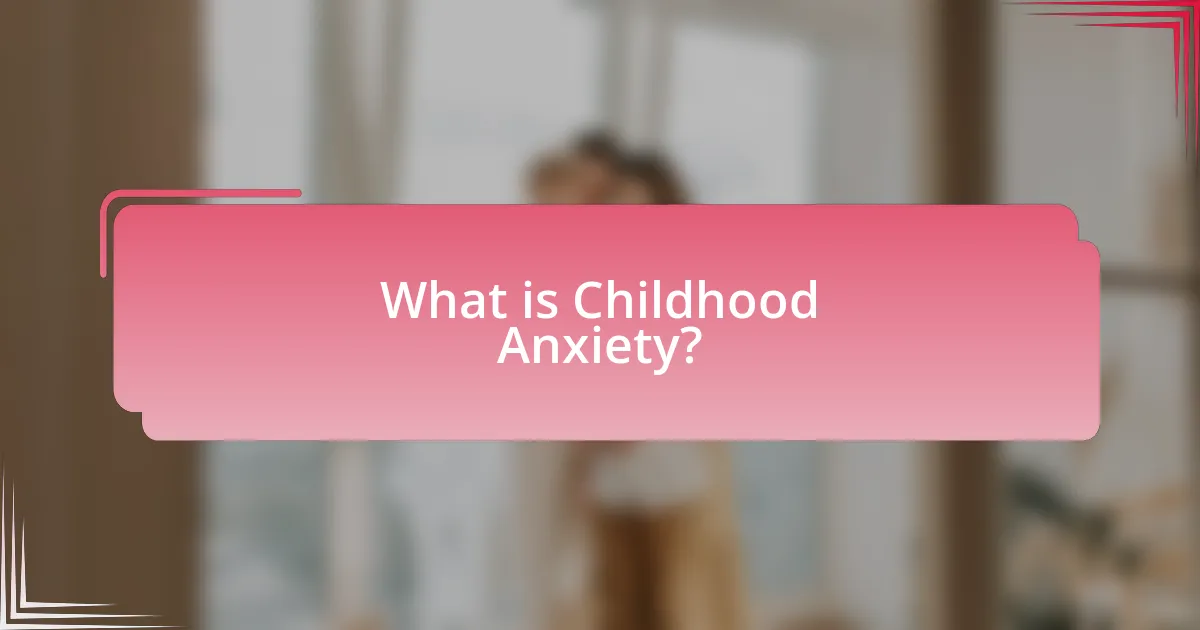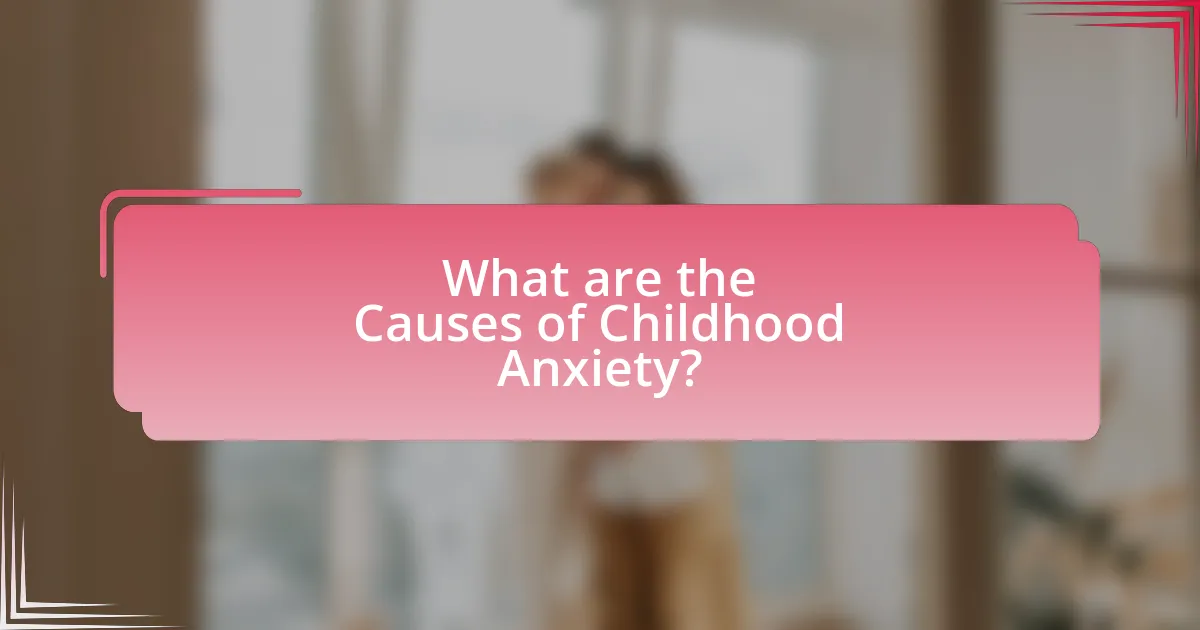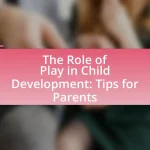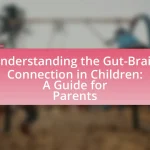Childhood anxiety is a psychological condition marked by excessive fear or worry that disrupts a child’s daily life, affecting around 7% of children aged 3 to 17 in the United States. This article explores the various manifestations of childhood anxiety, including symptoms such as persistent worry, avoidance of social situations, and physical complaints like stomachaches. It emphasizes the importance of recognizing these signs for early intervention and discusses the impact of anxiety on a child’s emotional, social, and academic development. Additionally, the article outlines the causes of childhood anxiety, including genetic, environmental, and psychological factors, and offers practical strategies for parents to support their children, including therapy options and effective coping techniques.

What is Childhood Anxiety?
Childhood anxiety is a psychological condition characterized by excessive fear or worry that interferes with a child’s daily activities. This condition can manifest in various forms, including generalized anxiety disorder, separation anxiety, and social anxiety, affecting approximately 7% of children aged 3 to 17 in the United States, according to the National Institute of Mental Health. Symptoms may include persistent worry, avoidance of certain situations, and physical symptoms like stomachaches or headaches. Understanding childhood anxiety is crucial for parents to provide appropriate support and interventions.
How does Childhood Anxiety manifest in children?
Childhood anxiety manifests in children through various emotional and behavioral symptoms. Common signs include excessive worry about everyday situations, avoidance of social interactions, and physical symptoms such as stomachaches or headaches. Research indicates that approximately 7% of children experience anxiety disorders, which can lead to difficulties in school and relationships if left unaddressed. Additionally, children may exhibit irritability, restlessness, and difficulty concentrating, further highlighting the impact of anxiety on their daily lives.
What are the common signs of Childhood Anxiety?
Common signs of childhood anxiety include excessive worry, avoidance of certain situations, physical symptoms like stomachaches or headaches, irritability, and difficulty concentrating. Research indicates that children may express anxiety through behavioral changes, such as clinginess or withdrawal from social interactions. According to the National Institute of Mental Health, approximately 7% of children aged 3-17 experience anxiety disorders, highlighting the prevalence of these signs in the population.
How can parents identify symptoms of Childhood Anxiety?
Parents can identify symptoms of childhood anxiety by observing behavioral changes, emotional responses, and physical signs in their children. Common indicators include excessive worry about everyday situations, avoidance of social interactions, irritability, and difficulty concentrating. Additionally, children may exhibit physical symptoms such as stomachaches, headaches, or sleep disturbances. Research indicates that approximately 7% of children experience anxiety disorders, highlighting the importance of recognizing these symptoms early for effective intervention.
Why is it important to understand Childhood Anxiety?
Understanding childhood anxiety is crucial because it directly impacts a child’s emotional and psychological development. Recognizing the signs and symptoms of anxiety allows parents and caregivers to provide timely support, which can prevent long-term mental health issues. Research indicates that approximately 7% of children experience anxiety disorders, and early intervention can significantly improve outcomes, reducing the risk of depression and social difficulties later in life. By understanding childhood anxiety, parents can foster a supportive environment that promotes resilience and coping strategies, ultimately enhancing their child’s overall well-being.
What impact does Childhood Anxiety have on a child’s development?
Childhood anxiety significantly impairs a child’s development by affecting emotional, social, and academic growth. Children experiencing anxiety often struggle with emotional regulation, leading to increased irritability and mood swings. This emotional instability can hinder their ability to form healthy relationships with peers, resulting in social withdrawal and isolation. Furthermore, anxiety can negatively impact academic performance, as anxious children may have difficulty concentrating, completing assignments, or participating in class discussions. Research indicates that children with anxiety disorders are at a higher risk for developing additional mental health issues, such as depression, later in life, which further complicates their developmental trajectory.
How can Childhood Anxiety affect a child’s social interactions?
Childhood anxiety can significantly impair a child’s social interactions by causing avoidance of social situations and difficulty in forming relationships. Children experiencing anxiety may feel overwhelmed in group settings, leading them to withdraw or refuse invitations to playdates or gatherings. Research indicates that children with anxiety disorders often exhibit symptoms such as excessive worry, fear of negative evaluation, and social withdrawal, which can hinder their ability to engage with peers effectively. For instance, a study published in the Journal of the American Academy of Child & Adolescent Psychiatry found that children with social anxiety disorder are more likely to experience isolation and have fewer friendships compared to their non-anxious peers. This lack of social engagement can further exacerbate feelings of loneliness and anxiety, creating a cycle that negatively impacts their social development.

What are the Causes of Childhood Anxiety?
Childhood anxiety is primarily caused by a combination of genetic, environmental, and psychological factors. Research indicates that children with a family history of anxiety disorders are more likely to develop anxiety themselves, highlighting the genetic component. Environmental factors such as exposure to stressful life events, parental anxiety, and negative parenting styles can also contribute significantly to the development of anxiety in children. Additionally, psychological factors, including temperament and cognitive patterns, play a crucial role; for instance, children who are naturally more sensitive or have a tendency to overthink may be more susceptible to anxiety. Studies have shown that these interconnected causes can lead to various anxiety disorders, affecting a child’s emotional and social development.
How do environmental factors contribute to Childhood Anxiety?
Environmental factors significantly contribute to childhood anxiety by creating stressors that affect a child’s emotional and psychological well-being. Factors such as exposure to violence, family instability, and socioeconomic challenges can lead to heightened anxiety levels in children. For instance, research published in the Journal of the American Academy of Child & Adolescent Psychiatry indicates that children living in high-crime neighborhoods exhibit increased anxiety symptoms due to constant fear and insecurity. Additionally, parental stress and conflict within the home environment can exacerbate a child’s anxiety, as children often absorb the emotional states of their caregivers. Studies show that children from families experiencing financial hardship are more likely to develop anxiety disorders, highlighting the impact of economic stressors on mental health.
What role do family dynamics play in Childhood Anxiety?
Family dynamics significantly influence childhood anxiety by shaping emotional responses and coping mechanisms. Research indicates that children from families with high conflict, poor communication, or inconsistent parenting styles are more likely to experience anxiety disorders. For instance, a study published in the Journal of Abnormal Child Psychology found that children exposed to parental anxiety and negative family interactions are at a greater risk for developing anxiety symptoms. This correlation highlights the importance of a supportive family environment in mitigating anxiety in children.
How can school-related stressors lead to Childhood Anxiety?
School-related stressors can lead to childhood anxiety by overwhelming children with academic pressures, social challenges, and performance expectations. These stressors, such as high-stakes testing, bullying, and the fear of failure, can trigger feelings of inadequacy and fear, which are key components of anxiety. Research indicates that children exposed to chronic stress in school environments are more likely to develop anxiety disorders, as evidenced by a study published in the Journal of Abnormal Psychology, which found that 30% of children experiencing significant school stress reported symptoms of anxiety.
What genetic factors are associated with Childhood Anxiety?
Genetic factors associated with childhood anxiety include variations in specific genes related to neurotransmitter systems, particularly those affecting serotonin and dopamine. Research indicates that polymorphisms in the serotonin transporter gene (5-HTTLPR) and the dopamine receptor gene (DRD4) are linked to increased susceptibility to anxiety disorders in children. A study published in the journal “Biological Psychiatry” by Caspi et al. (2003) found that children with a short allele of the 5-HTTLPR gene exhibited heightened anxiety responses to stressful life events, demonstrating a clear genetic influence on anxiety predisposition. Additionally, twin studies suggest that heritability estimates for childhood anxiety disorders range from 30% to 50%, indicating a significant genetic component in the development of these conditions.
How does a family history of anxiety disorders influence a child’s risk?
A family history of anxiety disorders significantly increases a child’s risk of developing similar conditions. Research indicates that children with a parent or sibling who has an anxiety disorder are more likely to experience anxiety themselves, with studies showing heritability estimates for anxiety disorders ranging from 30% to 50%. This genetic predisposition, combined with environmental factors such as parenting styles and family dynamics, contributes to the heightened risk. For instance, children may inherit not only genetic vulnerabilities but also learn anxious behaviors and coping mechanisms from their family members, further increasing their likelihood of developing anxiety disorders.

What Solutions are Available for Parents Dealing with Childhood Anxiety?
Parents dealing with childhood anxiety can utilize several effective solutions, including cognitive-behavioral therapy (CBT), mindfulness practices, and establishing a supportive home environment. CBT has been shown to reduce anxiety symptoms in children by helping them identify and challenge negative thought patterns. Mindfulness practices, such as deep breathing and meditation, can help children manage anxiety in real-time by promoting relaxation and focus. Additionally, creating a supportive home environment that encourages open communication and emotional expression can significantly alleviate anxiety symptoms, as children feel more secure and understood. Research indicates that these approaches can lead to improved emotional regulation and coping skills in children facing anxiety.
How can parents support their child in managing anxiety?
Parents can support their child in managing anxiety by fostering open communication and creating a safe environment for expression. Encouraging children to share their feelings helps them articulate their anxiety, which can reduce its intensity. Research indicates that children who feel heard and understood are more likely to develop effective coping strategies. Additionally, parents can model healthy coping mechanisms, such as mindfulness and relaxation techniques, which have been shown to decrease anxiety symptoms in children. Providing consistent routines and setting realistic expectations also contributes to a sense of stability, further aiding in anxiety management.
What techniques can parents use to help their child cope with anxiety?
Parents can help their child cope with anxiety by implementing techniques such as establishing a routine, encouraging open communication, and teaching relaxation strategies. Establishing a consistent daily routine provides children with a sense of security and predictability, which can reduce anxiety levels. Encouraging open communication allows children to express their feelings and fears, fostering a supportive environment where they feel understood. Teaching relaxation strategies, such as deep breathing exercises or mindfulness practices, equips children with tools to manage their anxiety in stressful situations. Research indicates that these techniques can significantly improve children’s ability to cope with anxiety, as they promote emotional regulation and resilience.
How important is open communication in addressing Childhood Anxiety?
Open communication is crucial in addressing childhood anxiety as it fosters a supportive environment where children feel safe to express their feelings. When children can openly discuss their fears and worries, parents and caregivers can better understand the root causes of anxiety and provide appropriate support. Research indicates that children who engage in open dialogue about their emotions are more likely to develop effective coping strategies, leading to reduced anxiety levels. For instance, a study published in the Journal of Child Psychology and Psychiatry found that children who experienced supportive communication with their parents showed lower levels of anxiety symptoms. Thus, open communication not only helps in identifying anxiety triggers but also strengthens the parent-child relationship, facilitating better emotional regulation in children.
What professional resources are available for Childhood Anxiety?
Professional resources available for childhood anxiety include licensed therapists, pediatricians, and school counselors. Licensed therapists, such as clinical psychologists and licensed clinical social workers, provide evidence-based treatments like cognitive-behavioral therapy (CBT), which has been shown to effectively reduce anxiety symptoms in children. Pediatricians can offer initial assessments and referrals to mental health specialists, ensuring comprehensive care. School counselors play a crucial role in identifying anxiety symptoms and providing support within the educational environment. According to the American Psychological Association, early intervention and access to professional resources significantly improve outcomes for children experiencing anxiety.
How can therapy benefit children experiencing anxiety?
Therapy can significantly benefit children experiencing anxiety by providing them with coping strategies and emotional support. Through various therapeutic approaches, such as cognitive-behavioral therapy (CBT), children learn to identify and challenge negative thought patterns, which helps reduce anxiety symptoms. Research indicates that CBT is effective in treating anxiety disorders in children, with studies showing that approximately 60-80% of children experience a reduction in anxiety symptoms after completing therapy. Additionally, therapy creates a safe space for children to express their feelings, fostering resilience and improving their overall emotional well-being.
What role do support groups play in helping families manage Childhood Anxiety?
Support groups play a crucial role in helping families manage childhood anxiety by providing a platform for shared experiences, emotional support, and practical coping strategies. These groups facilitate connections among parents facing similar challenges, allowing them to exchange insights and resources that can alleviate feelings of isolation. Research indicates that participation in support groups can lead to reduced anxiety levels in both children and their parents, as families learn effective management techniques and gain confidence in addressing their child’s needs. For instance, a study published in the Journal of Child and Family Studies found that parents who engaged in support groups reported improved coping skills and a better understanding of anxiety disorders, which directly benefited their children.
What practical strategies can parents implement at home?
Parents can implement structured routines at home to help manage childhood anxiety effectively. Establishing consistent daily schedules provides children with a sense of security and predictability, which can alleviate anxiety symptoms. Research indicates that children thrive in environments where they know what to expect, as it reduces uncertainty and stress. Additionally, parents can encourage open communication by creating a safe space for children to express their feelings, which fosters emotional intelligence and coping skills. Engaging in mindfulness activities, such as deep breathing exercises or meditation, can also be beneficial, as studies show that these practices can significantly reduce anxiety levels in children.















